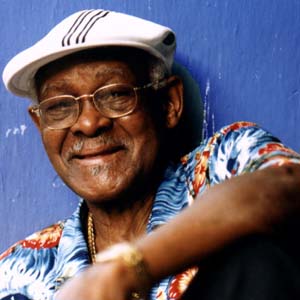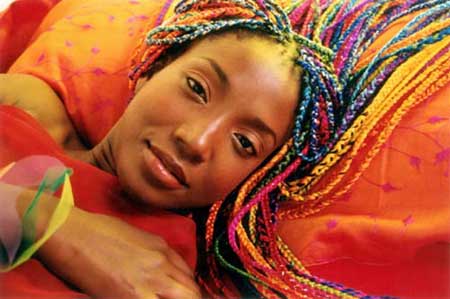Afro-Latino music is a result of a marriage between the Spanish guitar and the African drum.
----Harry Belafonte
=======================================================================
1. The late Ibrahim Ferrer (Santiago de Cuba): In 1998, he became famous in the film ”Buena Vista Social Club” but has been around singing for decades.

2. Jairo Varela (Chocó, Colombia): The late director, producer, songwriter, and vocalist of the famous salsa band Grupo Niche.
3. Africando (Dakar, Senegal, West Africa): In their very first CD, they stated that their mission is to bring salsa music back to its African roots. Africando sings salsa in Spanish, French, and their native tongue
Wolof.
4. Lucresia (Barcelona, Spain): This jazzy Cuban-born singer was once dubbed as the young Celia Cruz, but has come into her own as a Latin jazz singer. She sings the hell out of the song, La Noche de la Iguana (The Night of the Iguana).
5. The Lebron Brothers (Brooklyn, NY): This Nuyorican (New York Puerto Rican) group made up of Angel, José, Carlos, Frankie, and Pablo is known for salsa, Latin Boogaloo, and Latin Soul music.
6. Susana Baca (Lima, Perú): A world traveling diva who improvised on Afro-Peruvian music, crossing it with jazz, salsa, blues, and Afro-Cuban music.
7. Wilmer Cartagena (Lima, Perú): He is singing the shadows of his brother, Antonio, and is the singer of my favorite salsa song Un Amor Como El Tuyo

8 Elio Revé, (Guantánamo, Cuba): Unfortunately, he is no longer with us, but his Changui music lives on.
9. Ricardo Lemvo (Los Angeles, CA by way of the Democratic Republic of the Congo).
10. Cuco Valoy, Dominican Republic








I love the mix of Latin and African music. I have been looking for artist that combine the two musical genres, even though they are similar anyway.
ReplyDeleteAlmost every Latin-American country, including México (jarocho music) has its own versions of Latin and African music; different sounds, same roots.
ReplyDeleteNice list, but how come Celia Cruz is mentioned, but not actually on it? She was, is, and always will be la reina!
ReplyDeleteHi Paul, although I love and respect Celia's success as a “sistah,” She doesn't move me like the others listed above, even though I enjoy some of her music.
ReplyDeleteHey Bill,
ReplyDeleteInteresting post. I can understand your reasoning for not putting Celia. I was in Cuba when she passed away and unfortunately there was no mention of her in the noticias pero what about La Lupe? She's the Cuban Patti Labelle. I wish I were alive to see her in concert. My family in NY said she was AMAZING... and a character on stage.
I believe the reason Cubans made no mention of her is because she left Cuba, like she is a traitor to the Cuban revolution. When I was in Cuba, I looked for the music of Lucresia and couldn't find her. She lives in Spain, and like Celia, she speaks out against the Castro regime.
ReplyDeleteHave you ever heard of Toto La Momposina? She is a true representative of Afro & Native American and the marriage between the two.
ReplyDeleteWould you recommend a couple of her favorite songs? Where is she from, originally?
ReplyDeleteToto was born in Mompox, Colombia...her repertoire of songs are plenty and varied including many African and native American rhythms. This is a brief list and links to only a few of my favourite songs.
ReplyDeleteMargarita
http://www.youtube.com/watch?v=ZF9m85B-3HI
El Pescador
http://www.youtube.com/watch?v=BAPh04Ay_0Q
Pacanto
http://www.youtube.com/watch?v=ba8Za1nQdGU
Indios Farotas
http://www.youtube.com/watch?v=2fF9-knWZfQ
Cien Años de Soledad
http://www.youtube.com/watch?v=WiJeIUB4dLc
And you can't miss this fabulous documentary on her.
http://www.youtube.com/watch?v=j3hyE43ALbQ
There are many other cantadoras like her from Colombia such as Petrona Martinez, Martina Camargo, the late Etelvina Maldonado from Ale Kuma and a white Colombian lady Maria Mulata, who has profoundly studied the Afro-Colombian traditions.
The above of course is just music from the Caribbean coast of Colombia. Music from the Pacific coast of Colombia is distinctly different and is even declared UNESCO patrimony. Artists like Hugo Calendario, Grupo Socavon, Grupo Naidy, Grupo Bahia.
And then of course there's the Colombian islands of San Andres and Providence with a very strong Anglo-Caribbean heritage. See Roots Radical.
http://www.youtube.com/watch?v=ss3pIdeWkW4
Also can't forget the big Salsa artists of the 70s such as Fruko, Joe Arroyo, Joe Madrid, Jairo Licazale, Willy Salcedo, Jimmy Salcedo, Juan Piña and Piper Pimienta. This video is a national treasure.
http://www.youtube.com/watch?v=QtDfCxp462w
All this is just scratching the surface...the African traditions in Colombia are extremely wide and varied.
Johnathan,
ReplyDeleteI appreciate this very much. This is what I love about blogging.
Bill
Sounding good, Johnathan :-) I'm listening to Margarita.
ReplyDelete